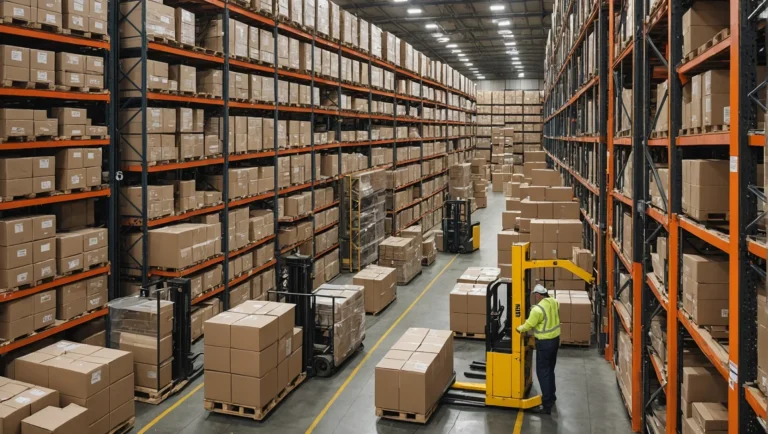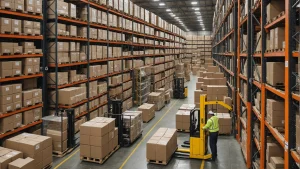The advantages of wholesale distribution can greatly enhance your business efficiency and profitability. By buying and selling in bulk, you reduce costs and streamline supply chains, making your operations more efficient. This strategy also opens doors to new markets and valuable partnerships.
Another important aspect of the advantages of wholesale distribution is faster product turnarounds, allowing your brand to reach a wider audience. Additionally, reduced marketing expenses positively impact your bottom line, making wholesale distribution an effective strategy for business growth.

Metrobi has been a game changer for wholesalers industry.
With Metrobi, you can save 23% on delivery costs, save 80% of the time from managing deliveries, and delight your customers with delivery notifications & tracking.
What is Wholesale Business Distribution?
-
Buy products in bulk from manufacturers.
-
Sell those products to retailers or other businesses.
-
It cuts out the middleman, leading to lower costs.
Examples of Wholesale Distribution
Wholesale distribution involves a variety of industries. For example, electronic distributors buy gadgets in large quantities directly from manufacturers. They then sell them to tech stores and other retailers. This model ensures that stores have a steady supply, and manufacturers can focus on producing goods. Looking for guidance on how to discover a distributor for bulk purchases in your area? This guide outlines the essential steps to identify and evaluate wholesale distributors for your business needs.
Another example is in the food and beverage industry. Food wholesalers purchase vegetables, fruits, and other produce in bulk. They distribute these items to local grocery stores, restaurants, and food service providers. This system helps small retailers access a wide range of fresh products without the need to deal with multiple suppliers.
Types of Wholesale Distribution Business
Full-Service Wholesalers
Full-service wholesalers provide more than just products. They often offer storage solutions, transportation, and marketing support. They usually handle a broad range of items, making them a one-stop-shop for many retailers. By dealing with a full-service wholesaler, retailers can save time and effort. They don’t have to find separate providers for storage or transportation.
Limited-Service Wholesalers
Limited-service wholesalers focus on specific services. For instance, some may only provide delivery services or storage facilities. They tend to specialize in a narrower selection of products, which allows them to offer expertise in certain categories. Retailers looking for specific items or services often prefer limited-service distributors to specialize than wholesalers. They can get specialized support without paying for extra services they don’t need.
Cash-and-Carry Wholesalers
Cash-and-carry wholesalers are another category. These wholesalers sell products to retailers who warehouse, pay in cash, and carry goods away themselves. This model is popular for small businesses that require fewer items but prefer lower costs. Due to the reduced services, prices are often lower compared to full-service wholesalers.
Benefits of Wholesale Distribution Models
Wholesale distribution models offer increased reach, cost efficiency, and improved supply chain management. They help you reach a wider network of retailers, optimizing both operations and costs. A critical aspect to consider in optimizing your logistics is the role of reliable courier services. For businesses looking to enhance their delivery capabilities, utilizing a trustworthy service can ensure timely and efficient product transport. Learn more about how you can benefit from a premium same-day courier service in Miami to streamline your distribution process.
For in-depth exploration, consider reading “Distribution Channels: Understanding and Managing Channels to Market” by Julian Dent. It covers the complexities of different wholesale models and offers practical insights.
Arguments for Wholesale Distribution
Wholesale distribution ensures large-scale, efficient operations. It simplifies the supply chain, reducing the need for multiple intermediaries. This leads to lower costs for retailers and more competitive pricing for consumers. On top of that, wholesalers provide valuable services like inventory management and transportation, enhancing supply chain stability and overall efficiency.
Arguments Against Wholesale Distribution Industry
However, there are arguments against the wholesale model. Smaller retailers may face high minimum order requirements that they can’t meet. Additionally, wholesalers often deal with standardized products, which might limit variety for niche markets.
For those looking to leverage data analytics in wholesale distribution, platforms like Phocas Software provide tools for tracking important KPIs such as picking accuracy and packing costs.
Overall, understanding the intricacies of wholesale distribution can be key to making informed business choices. It’s more than buying in bulk; it’s about effectively managing relationships, inventory, and services to help businesses grow.

Save 80% of the time from managing deliveries and drivers.
Metrobi provides a dedicated operations manager that coordinates drivers on your behalf and solves urgent issues.
Advantages of Wholesale Distribution Models
Expansion of Market Reach
One of the main benefits of wholesale distribution is the ability to reach a broader audience. Wholesalers supply products to numerous retailers, expanding the market reach far beyond what a manufacturer could achieve on its own. Supplying to multiple retailers through many wholesale distributors not only broadens the customer base but also diversifies revenue streams, reducing the risk associated with dependency on a few large clients.
Leveraging multiple distribution channels significantly increases brand visibility. Wholesalers place products across various retail environments, from brick-and-mortar stores to online platforms. This varied presence across online retail outlets ensures that consumers encounter the brand in different contexts, reinforcing brand recognition and facilitating consumer trust. For businesses looking to further enhance their distribution capabilities, exploring options like our popular same-day delivery service in Philadelphia can significantly improve customer satisfaction and speed of service.
Enhanced Supply Chain Efficiency
Wholesale distribution models enhance the efficiency of supply chain operations. By managing large volumes of inventory, wholesalers streamline processes such as sorting, packaging, and warehousing. Effective stock management systems ensure optimal levels of inventory are maintained, reducing both shortages and overstock situations. If you’re on the search for top-tier directories of wholesalers to enhance your supply chain efficiency, read on to discover the leading wholesale directories in the U.S.
A well-established wholesale and distribution center network ensures quicker movement of goods from manufacturers to retailers. This speed and reliability enable retailers to keep their shelves stocked, thus maintaining customer satisfaction. Advanced logistics and real-time tracking systems have significantly enhanced delivery times, making the whole supply chain more dependable.
The reduced delays and improved reliability in wholesale distribution models can lead to a consistent supply flow, which is critical in sectors where timely delivery is crucial, such as perishable goods.
Improved Cost Efficiency
One of the most compelling benefits of wholesale distribution is the economies of scale it brings. By purchasing in bulk, wholesalers can negotiate lower per-unit costs from manufacturers. This cost-saving can then be passed down the supply chain, leading to lower prices for retailers, and ultimately, consumers.
Selling in large volumes allows wholesalers to optimize their revenue streams. The volume sales model ensures a steady cash flow and the ability to handle sizeable transactions at once.
Continuing to explore these benefits can offer invaluable insights into optimizing wholesale operations. Advanced strategic guides such as Andrew R. Thomas’s critique provide a nuanced understanding of the challenges and benefits within this sector.
Closing the section with an emphasis on further reading solidifies the depth of the wholesaling model’s benefits, encouraging professionals to delve deeper into specialized literature for enhanced comprehension.
Cost Efficiency in Wholesale Distribution
Economies of Scale
Economies of scale capitalize on the cost advantages that arise when companies increase production volume. When manufacturers produce goods in bulk, their per-unit production cost decreases. This cost saving is passed down to wholesalers, who can buy products at reduced prices.
Lower Production Costs
Bulk production allows manufacturers to spread fixed costs, such as machinery and labor, over a larger number of units. The end result is a lower cost per unit. For wholesalers, purchasing these bulk-produced goods means they can withstand competitive pricing environments while still securing a healthy margin.
Higher Profit Margins
With lower purchasing costs, wholesalers can secure higher profit margins. The savings on the production side mean wholesalers can buy more for less and sell at competitive prices. This allows them to gain a better footing in the market while offering attractive deals to retailers. Profit margins, though variable, are generally healthier in wholesale distribution due to these scaled savings.
Reduced Marketing Expenses
Marketing is a significant expense for businesses, but wholesalers can leverage retailer promotions to reduce their marketing costs. Instead of targeting end consumers by selling directly themselves, wholesalers focus on building strong relationships with retailers, who then take on the task of marketing the products to final buyers.
Wholesalers depend on retailers to drive consumer awareness and sales through their promotional activities. This dependency reduces the need for wholesalers to invest heavily in their marketing campaigns. Since retailers are more in touch with end consumers, their promotions are generally more effective.
Wholesalers can allocate resources to maintain strong relationships with retailers instead of diversifying their efforts across multiple consumer-facing campaigns. These relationships lead to repeat business and long-term contracts, reducing the need for constant marketing outreach.
Lower Storage Costs
Wholesalers often manage large warehouses but benefit from quick turnover rates, keeping storage costs relatively low. The ability to handle and move products efficiently cuts down on storage times and costs. Optimizing warehouse operations using data analytics further enhances these cost savings.
Utilizing sophisticated inventory management systems reduces the cost of holding inventory. Technologies like RFID and IoT enable real-time tracking and forecasting, which leads to better inventory turnover.
Streamlined Supply Chain
Wholesale distributors often have systems in place to ensure order fulfillment and processing are handled swiftly and accurately. This reduces overhead and operational costs and contributes to overall cost efficiency.
A well-optimized supply chain results in timely product deliveries, reducing the need for excess buffer stock and minimizing waste. This has a direct impact on lowering costs tied to the expiration and obsolescence of products, which is particularly important in sectors like perishable goods.
Minimized Risk of Overstocking
One often overlooked advantage of the wholesale distribution channel is the reduced risk of overstocking, which can weigh heavily on a company’s resources. Effective forecasting and inventory management can significantly decrease the odds of tying up capital in unsold stock. Additionally, a reliable Washington DC courier service can ensure timely deliveries, enhancing the efficiency of your wholesale distribution operations. Such services are essential for maintaining smooth logistics and meeting the demands of retailers promptly, thereby contributing to overall customer satisfaction.
Wholesalers use advanced analytics to predict demand with greater accuracy, ensuring they stock the right amount of products to meet market needs without overspending on storage. Accurate demand forecasting helps to avoid markdowns, which can erode profit margins.
Wholesale Distribution and Market Reach
Entry into New Geographies
Wholesale distribution lets businesses reach new markets without setting up their outlets. This is particularly useful for testing new regions with minimal investment. When a business partners with a wholesale distributor, it can explore new geographies more efficiently. It avoids the significant costs and logistical challenges of establishing a physical presence.
By working with wholesale distributors, companies can leverage existing distribution networks. This approach allows them to focus on their core competencies while expanding their market presence.
Moreover, the wholesale business can serve as a vital link in the global supply chain, distributing products between business partners worldwide. The ability to test and adapt to new markets with lower financial risk is invaluable. Companies can evaluate market demands and customer behaviors before committing to full-scale operations, minimizing potential losses and maximizing strategic gains.
Increased Retailer Partnerships
Wholesale distribution provides the benefit of a distribution partner forming partnerships with multiple retail chains. These partnerships allow businesses to tap into a broader customer base without the need for direct consumer outreach. Once connected with a wholesale distributor, a business gains access to numerous retailers who can sell its products, thereby multiplying its market presence.
One significant advantage is that wholesale distributors often carry diverse product lines and offer superior customer service. This dual offering makes them valuable partners for retailers looking to broaden their inventory without increasing operational complexity.
Leveraging Retailers’ Customer Base
By leveraging the customer base of retail partners, wholesalers can significantly enhance their sales volume. Retailers have established relationships with consumers and understand the local market, enabling wholesalers to indirectly benefit from this existing customer knowledge and trust. This relationship not only improves sales but also strengthens the brand presence within different regions.
When retailers promote a product, they use their marketing channels, saving manufacturers and wholesalers from the expense and complexity of end-consumer marketing. Retailer promotions are crucial, as they drive sales growth and improve product visibility on the shop floor.
Risk Mitigation and Market Testing
Wholesale distribution reduces the risks associated with market entry. When manufacturers sell directly to retailers through wholesalers, they avoid the large upfront costs of setting up stores and managing retail operations. This approach facilitates safer entry into new markets and allows businesses to adapt based on real-time market feedback.
Testing a new market through a wholesale distributor helps in assessing product demand and consumer preferences. If a product doesn’t perform well in a new area, it is easier and less costly to pivot or withdraw than it would be if the business had invested heavily in physical retail infrastructure. This flexibility is crucial for dynamic market conditions.
Economic Scale and Global Reach
Finally, wholesale distribution benefits from economies of scale. Wholesale distributors can purchase in large volumes at reduced costs, and then redistribute products to various retailers. This approach not only offers competitive pricing but also frees the larger wholesale distributors and manufacturers from complex inventory and logistics management.
Wholesale distribution facilitates global reach through its established networks, enabling businesses to operate on a much larger scale. Wholesalers can navigate regulatory requirements and logistical complexities that might be prohibitive for individual businesses. This expansive network is essential for tapping into global market opportunities.
Improving Supply Chain Through Wholesale Distribution
Optimized Inventory Management
For businesses, keeping the right amount of stock is crucial. Too much stock ties up capital and space. Too little means missing out on sales. Wholesale distribution helps balance this.
Wholesalers buy in bulk and distribute to retailers. This model allows businesses to maintain sufficient stock levels without overstocking. Wholesale distribution uses data analytics to forecast demand accurately. Tools like inventory management software can help adjust stock levels based on these forecasts. These systems integrate with sales data to predict future demand and adjust inventories.
Data analytics plays an essential role here. Advanced algorithms analyze past sales trends to forecast future demand. This method reduces the risk of stockouts or overstocking. Phocas Software is a good example of a tool that tracks key performance indicators (KPIs) to guide decisions.
Faster Product Turnaround
Wholesale distribution speeds up product movement from manufacturers to retailers. This is possible due to streamlined processes and efficient logistics.
Wholesalers invest in logistics systems to ensure quick and accurate delivery. This reduces handling time and speeds up the whole supply chain process. Advanced technologies like the Internet of Things (IoT) and machine learning enhance this process. They provide real-time tracking and predictive analytics.
Efficient handling processes minimize delays. Swift transport and handling mean products reach retailers faster. This is vital for perishable goods where delays can lead to losses. Wholesale distributors often have robust logistics networks that cut down transit times.
Strategic Partnerships with a Wholesale Distributor
Forming strategic partnerships with wholesalers can significantly improve supply chain efficiency. These partnerships enable businesses to tap into the wholesaler’s distribution network, reducing their logistical burden.
Lowe’s Home Improvement demonstrates this by opening multiple warehouses to handle off-season merchandise. This strategy reduces transportation costs and enhances delivery efficiency. This consolidation ensures that products are always available when needed.
Enhanced Technology Use
Embracing digital tools can transform supply chains. Digital transformation enables real-time tracking, predictive demand forecasting, and optimized routing.
Technologies like AI, machine learning, and IoT bring significant improvements. They help in real-time tracking of goods and predictive analytics for demand forecasting. These technologies also aid in route optimization, ensuring timely deliveries.
Inventory Automation
Wholesale distribution often leverages automation to maintain optimal inventory levels. This technology reduces manual errors and improves efficiency.
Warehouse Management Systems (WMS)
Implementing a WMS boosts warehousing productivity and accuracy. This system allows for real-time inventory tracking and better stock management. It helps businesses maintain the right amount of inventory, reducing holding costs.
Automation tools help with accurate demand forecasting. This keeps inventory levels optimized and reduces the risk of overstocking or stockouts.
A useful reference for those interested in further study on inventory management and automation would be “Fundamentals of Supply Chain Theory.” It offers deeper insights into how these systems function and their benefits.
Collaborative Environment
Ensuring seamless communication between all supply chain parties reduces issues. It helps in mitigating delays and improves overall efficiency.
Communication
Effective communication is vital. All parties, from manufacturers to retailers, need to stay informed. This collaboration ensures that issues are quickly addressed and resolved. It also helps in better planning and execution of supply chain activities.
Data Analysis
Analyzing supply chain data helps identify performance gaps. These insights inform strategic decisions for continuous improvement. Companies can leverage data to spot inefficiencies and opportunities for cost-saving.
By enhancing supply chain operations, wholesale distribution delivers substantial benefits to businesses. The model helps in optimizing inventory management, speeding up product turnaround, and leveraging strategic partnerships. Advanced technologies and collaborative environments play crucial roles.
How does Wholesale Distribution Work?
Step #1: Sourcing Products
To start, you need to find reliable manufacturers. These are companies that produce goods you want to distribute. You should focus on manufacturers that can offer good prices and consistent quality. Negotiation is key here. Discuss pricing, delivery timelines, and minimum order quantities. A strong contract lays the foundation for a smooth operation. Most distribution channels in the U.S. are highly fragmented, with many small companies navigating these negotiations. To ensure ongoing success, educate yourself on how to identify an ideal bulk supplier partner who can provide competitive prices, quality products, and dependable fulfillment processes.
Secure Products Based on Market Demand
Once you’ve identified manufacturers, it’s crucial to choose the right products. Analyze market trends and customer needs to make an informed decision. Use tools like market research reports and customer feedback surveys. Ensure the products you select are in high demand to maximize sales.
Step #2: Inventory Management
Efficient storage is essential. Products should be kept in strategically located warehouses. This reduces shipping times and costs. Use warehouse management systems (WMS) to keep everything organized. WMS uses real-time tracking to manage stock.
Monitor Stock Levels and Prepare for Orders
Your next task is to continuously monitor stock levels. You need to know exactly how much inventory is available at all times. Inventory management software can help here. It not only tracks stock but also alerts you when you need to reorder. This ensures you never run out or overstock, minimizing holding costs.
Step #3: Order Fulfillment
Order processing begins the moment a retailer places an order. This involves confirming the order details, picking the items from the warehouse, and packaging them for shipment. Make sure your team is trained to handle these steps efficiently. Many tools integrate with warehouse management systems to automate order processing, reducing errors and speeding up the process.
Coordinate Shipping and Delivery Efficiently
The final step is shipping the products to the retailers. Choose reliable shipping partners who can guarantee timely delivery. Coordinate with these partners to ensure that shipping is done efficiently and cost-effectively. Use logistics management systems to streamline this process. These systems help in planning routes and tracking shipments in real time.
Successful wholesale distribution involves these core steps: sourcing products, managing inventory, and fulfilling orders. Each step requires careful planning and execution to ensure the product gets from the manufacturer to the retailer efficiently. This not only improves supply chain efficiency but also enhances customer satisfaction. Looking for advice on how to connect with a reliable supplier for your bulk purchasing needs? Discover the ultimate guide to finding and assessing wholesale distributors in this article.
How to Leverage Wholesale Distribution for Business Growth
Strategy #1: Building Strong Supplier Relationships
Maintaining robust relationships with suppliers is crucial for wholesaling success. Strong supplier ties can lead to better prices, terms, and smoother operations.
Maintain Regular Communication with Manufacturers
Regular communication with your suppliers keeps operations running smoothly. Set up periodic check-ins and updates. Address any issues promptly to avoid disruptions. Use platforms like Slack or Microsoft Teams for quick updates. Email works for detailed communication.
Establish Trust and Negotiate Favorable Terms
Trust is built by being reliable and transparent. Ensure timely payments and be upfront about your needs. Negotiate terms that benefit both parties. Better pricing, extended payment terms, and prioritized delivery options are achievable with trust and open communication.
Strategy #2: Utilizing Technology for Efficiency
Technology enhances efficiency in modern wholesale distribution businesses. It automates tasks and provides data for better decisions.
Implement Inventory Management Software
Inventory management software helps track stock levels in real time. Tools like QuickBooks or Fishbowl Inventory reduce waste by preventing overstocking. They ensure you always have what you need without excessive surplus.
Use Data Analytics for Better Demand Forecasting
Data analytics can predict future market demands. Software like Tableau or Microsoft Power BI analyzes sales patterns and market trends. This helps you stock the right amount of products. Forecasting demand accurately minimizes waste and maximizes sales.
Strategy #3: Focusing on Customer Service
Good customer service keeps retailers returning. It’s not just about making a sale but building long-term relationships.
Train Staff to Handle Retailer Queries Efficiently
Staff should be well-trained to address retailer questions and issues. Provide regular training sessions. Create a FAQ document and use CRM systems like Salesforce to track retailer interactions and follow-ups.
Ensure Timely Delivery to Build Retailer Loyalty
Timely delivery is key to maintaining retailer loyalty. Use efficient logistics partners and reliable shipping methods. Tools like UPS’s Quantum View or FedEx’s InSight can track shipments in real time, ensuring transparency with your retailers. Meeting delivery deadlines consistently assures retailers of your reliability, encouraging repeat business.
Remember, leveraging wholesale distribution channels effectively involves strategic efforts across various fronts—supplier relations, technology use, and customer service. Implement these strategies to fuel your business growth.
What is the best approach for Small Businesses in Wholesale Distribution?
Focus on Niche Markets
-
Target markets that larger distributors might overlook.
-
Build expertise in a specific product category.
Small businesses should concentrate on niche markets. These are specific segments that larger distributors often ignore. By focusing on these areas, small businesses can avoid direct competition with larger entities and create a strong position in their chosen market.
To target a niche market:
-
Research Market Gaps: Look for areas where there is demand but limited supply. Use market research tools to identify trends and gaps.
-
Choose Your Specialty: Decide on a specific product category where you can excel. This could be something like organic foods, eco-friendly products, or artisanal goods.
-
Build Expertise: Gain deep knowledge about your chosen product category. Attend industry events, read relevant publications, and network with other professionals in your field.
-
Tailor Your Offerings: Develop products that meet the specific needs of your target market. This could involve creating unique packaging, offering customizations, or providing value-added services.
Leverage Online Platforms
-
Use e-commerce to reach more retailers.
-
Offer flexible payment and delivery options.
Using online platforms can greatly enhance your reach and convenience:
-
Set Up an E-Commerce Website: Create a user-friendly site where retailers can browse your products, place orders, and manage their accounts.
-
Utilize Online Marketplaces: List your products on platforms like Amazon Business, Alibaba, and other B2B marketplaces. This increases exposure and access to a wider audience.
-
Implement Flexible Payment Options: Offer various payment methods like credit cards, PayPal, and direct bank transfers. Some platforms also support buy now, pay later schemes for businesses.
-
Ensure User-Friendly Delivery Options: Partner with reliable logistics companies to offer various delivery options. Provide tracking information and ensure on-time delivery.
-
Use Digital Marketing: Leverage SEO, email marketing, and social media to promote your products. Digital marketing tools can help you reach more retailers and keep them engaged.
Prioritize Relationships Over Transactions
-
Build strong, long-term relationships with retailers.
-
Offer exceptional customer service to differentiate from competitors.
Strong relationships can set you apart from competitors:
-
Communicate Regularly: Check in with your retailers through emails, calls, or instant messaging. Keep them informed about new products, promotions, and any changes in your service.
-
Provide Personalized Service: Tailor your approach to meet the specific needs of each retailer. This could involve customized recommendations, exclusive deals, or priority service.
-
Resolve Issues Promptly: Address any complaints or problems swiftly and efficiently. A quick response can turn a negative experience into a positive one.
-
Offer Value-Added Services: This could include things like product training for retailer staff, marketing materials, or inventory management advice.
-
Gather Feedback: Regularly ask for feedback to understand how you can improve your products and services. Use this feedback to make continuous enhancements.
Making Wholesale Distribution Work for Your Business
Wholesale distribution expands your market reach, improves supply chain efficiency, and reduces costs. It allows access to new geographies, fosters retailer partnerships, and optimizes inventory management.
Remember, this model isn’t just cost-effective; it also simplifies your operations and boosts your profit margins. If you’re ready to take advantage of these benefits, here are your next steps:
-
Strengthen your supplier relationships.
-
Implement advanced inventory management systems.
-
Focus on exceptional customer service.




























